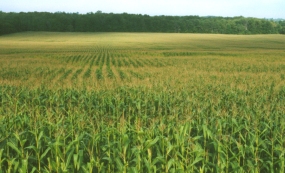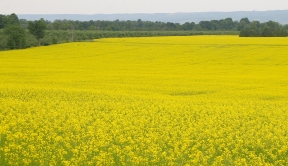Corn-Canola Comparisons: Neonic-Bee Problem Likely Unrelated to Pollen or Soil Residues
“Why are there problems for bees associated with the growing corn but not canola, when both are planted using neonic-treated seed?” A great question: asked from the floor during a recent Pollination Guelph panel discussion of which I was a part.
The question brought everything into focus.
The implied assumption – more bee problems with corn versus canola – is quite well supported. Although 70-80% of Canadian neonic seed treatment occurs in Western Canada, mostly with canola, the complaints about neonic-linked bee deaths are almost all from Ontario and Quebec where corn is more dominant. And while much of the anti-neonic outcry in Central Canada does come from traditional anti-pesticide voices, data such as that provided by Health Canada’s Pest Management Regulatory Agency do show linkages among corn, neonics and bee health, at least for some beekeepers.
Jim Coneybeare, a vice president of the Ontario Bee Association, told a major Farm & Food Care meeting last September that his bees thrive when making honey from canola (almost certainly grown from neonic-treated seed) but do poorly near corn and soybeans.
There is one obvious difference: While canola is an excellent source of nectar and pollen for bees (bees love canola) corn is the reverse. This wind-pollinated species produces no nectar and experts say bees forage it for high-protein pollen only if there are no better choices. Bees don’t much like corn and tend to avoid it. If you locate a few hives near corn fields, there are usually enough wild flowers nearby in fence rows and non-cropped lands to service the bees. But if you place many dozens of hives surrounded by corn, they’ll be malnourished. I’ve likened it to shopping for food supplies at Home Depot. (Canola is more like Walmart.)
Soybeans, a self-pollinating crop, are also a very poor source of nectar and pollen.
But on to the specific links with neonic seed treatments, where the corn-canola comparison is also highly informative: The rate of neonic application per hectare is virtually the same with the two crops and, according to available data summarized by the European Food Safety Authority (EFSA), the percent uptake by plants grown from treated seed is also similar. (Some anti-neonic advocates in Ontario have claimed uptake is four times greater with corn, listing their source as Dr. Christy Morrissey, University of Saskatchewan. But the underlying scientific paper provided to me by Dr. Morrissey (Sur and Stork, 2003) contains no such comparison.)
Hence, soil seeded to canola gets the same amount of neonic added annually as does soil seeded to corn. And rate of neonic breakdown should be no faster in canola-seeded Prairie fields than in those planted to corn in Ontario/Quebec. Indeed, breakdown should be slower in Western Canada because of lower average temperatures and less rainfall. If residual neonic in soil is a critical contributor to bee deaths as some, including Dr. Morrissey, claim, then we should hear as many complaints about bee deaths from canola as from corn – or maybe even more so. But we don’t. Almost all complaints to Health Canada’s Pest Management Regulatory Agency come from Ontario and Quebec.
Dr. Morrissey has garnered attention with a recent paper in Plos One (http://goo.gl/uJWOHr) focussing on neonic levels in Prairie sloughs (ponds within farm fields) but the data are not that convincing. When the measured concentrations are only a few parts per trillion, you can find almost anything anywhere. Morrissey’s data show neonic-in-water levels about the same magnitude as that for caffeine in the Great Lakes. In Quebec, Dr. Fournier reported elevated neonic levels at or above LD50 levels for bees in some surface waters, but subsequent calculations show she overestimated the risk to bees by at least a 20-fold factor.
So, if it’s not the soil, what about the pollen, especially given the claims by some beekeepers and anti-pesticide advocates that neonics in corn pollen are a critical cause of bee mortality?
In fact, the EFSA has looked at this in detail with some fairly detailed calculations of the daily uptake of worker bees foraging on corn and canola (called ‘oilseed rape,’ or OSR, in Europe). The concentration of neonics in pollen is about the same in corn and OSR, but of course corn has no nectar. The total amount of neonic gathered per day from nectar and pollen was estimated at least 10 times greater with OSR than corn (http://goo.gl/VVCqxF,http://goo.gl/kj5njU). In all cases, the amount of daily uptake from either flowers of corn or OSR was judged to be very minute.
Back to Canada, if neonic in pollen is a notable source of bee deaths, the problem should be much worse with canola than corn. But Jim Coneybeare’s bees thrive near canola fields. And Cutler and Scott-Dupree at the University of Guelph, in some detailed and extensive trials involving bees hives positioned within canola fields grown from treated seed, found no evidence of negative effects on bees (http://goo.gl/fvBSTu).
So that leads us to the one notable difference in neonic exposure between treated corn and canola – different planting technology – notably in the widespread use of vacuum pneumatic planters for seeding corn, though not for canola. On this, the evidence is quite clear, both in North American and European research (see EFSA links provided above for the latter): more neonic-laden dust from these corn planters can mean a greater risk of acute bee exposure at planting time. European research also shows that with proper planter modifications – notably, the release of planter exhaust dust at ground level and at a low air speed – 90%+ of the emission release into the surrounding air can be eliminated.
Bottom line: If we can get rid of the dust emission with corn planting – different planter design, better adherence of neonic treatment to seed, exhaust emission at the soil surface at slow speed – we should go most of the way in solving that portion of bee mortality associated with neonic usage in field crop agriculture.
That will leave the bee industry to deal with much bigger problems like bee pathogens, viruses (up to 100% of Ontario bees may be affected according to one unpublished survey), and proper nutrition. The latter or combinations involving pathogens/disease, poor nutrition and severe weather is why over-winter bee mortality has been exceptionally high in Ontario this year. And if beekeepers are looking to nourish, not starve, their bee colonies, don’t locate them near corn fields.
For those looking for a single, highly readable review covering all aspects of this neonic-bee issue with an international (including Canadian) perspective, I highly recommend this report, http://goo.gl/t3tDBC, from the Australian Pesticides and Veterinary Medicines Authority. Here’s another great review especially on effects of long-term, ‘sub-lethal’ exposure by Fairbrother et al (2014), http://goo.gl/NywA8T.
You can visit Terry Daynard's Blog at http://tdaynard.com/
Views: 809
Comment
© 2026 Created by Darren Marsland.
Powered by
![]()


You need to be a member of Ontario Agriculture to add comments!
Join Ontario Agriculture